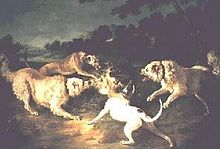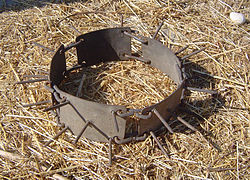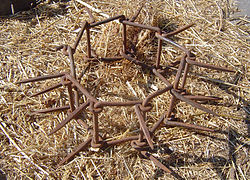- Maremma Sheepdog
-
Maremma Sheepdog 
A working Maremmano on the Gran Sasso of Abruzzo, Italy Other names Cane da Pastore Maremmano-Abruzzese
Pastore Abruzzese
Pastore MaremmanoNicknames Maremma Country of origin Italy Traits Classification and standards FCI Group 1 Section 1 #201 standard ANKC Group 5 (Working Dogs) standard KC (UK) Pastoral standard NZKC Working standard Notes Pastore Maremmano-Abruzzese – Italian Breed Standard Dog (Canis lupus familiaris) The Maremma Sheepdog, in Italian Cane da pastore Maremmano-Abruzzese, usually referred to as just Maremmano, is a breed of livestock guardian dog indigenous to central Italy, particularly to Abruzzo and the Maremma region of Tuscany and Lazio. It has been used for centuries by Italian shepherds to guard sheep from wolves. The English name of the breed derives from that of the Maremma marshlands, where until recently shepherds, dogs and hundreds of thousands of sheep over-wintered,[1] and where the breed is today abundant although sheep-farming has decreased substantially. The breed is widely employed in Abruzzo, where sheep herding remains vital to the rural economy and the wolf remains an active and protected predator. Similar breeds include the Pyrenean Mountain Dog, the Kuvasz of Hungary, the Tatra of Poland and the Šarplaninac (although not white), with all of which it may share a common ancestor;[2][3] and the Akbash Dog of Turkey. See Mountain dog breeds.
Contents
Description
Appearance
The Maremma Sheepdog has a solid, muscular build, a thick white coat, a large head and a black nose. According to the breed standard, males should weigh 35 to 45 kilograms (77 to 99 lb) and stand 65 to 73 centimetres (26 to 29 in) at the shoulder, while females weigh 30 to 40 kilograms (66 to 88 lb) and stand 60 to 68 centimetres (24 to 27 in). Some dogs may be considerably larger. The coat is long and thick; it is rough to the touch, and forms a thick collar around the neck. It should be solid white; some minor yellowing may be tolerated.[4]
Some divide the breed into various subtypes, largely based on small differences in physical attributes and with subtype names based on village and provincial names where the dogs may be found, e.g. the Maremmano, the Marsicano, the Aquilano, the Pescocostanzo, the Maiella, and the Peligno.[5] However, biologists dispute this division, as well as over reliance on minor physical differences, as the dogs were bred over the centuries for their behavioral characteristics as flock guardians.[citation needed]
Temperament
Despite their large size, Maremma Sheepdogs can be good companion dogs in areas with adequate open space. Centuries of breeding the dogs to be gentle with lambs but fiercely protective of their flock has created a breed that will bond to families and show a calm, intelligent disposition. However, the dogs may display hostility towards outsiders and they are not suitable companion dogs for urban areas due to their large size and need for open space. A ranch type environment works best, away from neighbor's property lines and road traffic. In this environment, a dog house is not necessary because the dogs prefer to sleep with livestock.[6]
History
 The canis pastoralis of Classical antiquity, in the Vatican Museums; the ears are a restoration. See also the Duncombe Dog
The canis pastoralis of Classical antiquity, in the Vatican Museums; the ears are a restoration. See also the Duncombe Dog
Ancient history and iconography
Descriptions of white sheep defence dogs are found in ancient Roman literature, in works such as those of Columella, Varro and Palladius. Similar dogs are depicted in numerous sculptures and paintings from Roman times to the present.[7] Among the earliest is the series of large statues (two in Rome, one in Florence, one – the Duncombe Dog – in England) copied from a Hellenistic bronze from Pergamon.[8] Iconographic sources that have been identified as relevant to the history of the Maremmano include:[8]
- A Hellenistic bas-relief, of which a drawing was published by Max von Stephanitz in 1901[9]
- A votive statuette in the Museo Archeologico of Capua
- A 14th century mediaeval fresco in the church of San Francesco in Amatrice, at the foot of the Monti della Laga, in the comune of Rieti; the dog wears a roccale
- A 14th century fresco in Santa Maria Novella, in Florence
- A 'Nativity' of Mariotto di Nardo (active 1394–1424); the dog wears a spiked collar, photograph
- Abraham and Lot on their way into Canaan by Bartolo Battiloro, in the Collegiata of San Gimignano

Jean-Baptiste Oudry, Hunting the Wolf, 1746,
in the Musée du Louvre- A detail of the Journey of the Magi to Bethlehem by Benozzo Gozzoli, c.1460
- Rough ink drawings on the maps of the pasture-lands of the Tavoliere di Foggia published in 1686 by Antonio and Nunzio Michele di Rovere
- A seventeenth century engraving of the Roman campagna by Joannes van den Hecke
- An eighteenth century maiolica of a bear-hunt by Candeloro Cappelletti (1689-1772) of Castelli, Abruzzo
- Hunting the Wolf by Jean-Baptiste Oudry, 1746, from the collection of Louis XV; the dogs to the left and right of the wolf are described in a catalogue of the museum as "large dog[s] with long hair".[10] Wolf dogs from the Abruzzo were imported into France at about this time. They were used by François Antoine, "Antoine de Beauterne", in his successful hunt for the Beast of Gévaudan in 1765;[8] according to Gobin, under Louis XV (r.1715–1774) the Venerie Royale or Royal Hunt was composed in large part of Abruzzese wolf-dogs and Sicilian mastiffs.[11]
- The cane da lupo or wolf-dog used by Vincenzo Dandolo to defend Spanish sheep on the mountains above Varese[12]
- An illustration in the Penny Magazine of 1833[13]
 "Wolf dogs of the Abruzzi", illustration from the Penny Magazine of 1833
"Wolf dogs of the Abruzzi", illustration from the Penny Magazine of 1833
- An engraving by Arthur John Strutt of a shepherd and his dog in the Roman campagna in 1843
- Several engravings by Charles Coleman in his collection A Series of Subjects peculiar to the Campagna of Rome and Pontine Marshes[14]
Recent history
Until 1958 the Pastore Maremmano ("Shepherd Dog of the Maremma") and the Pastore Abruzzese ("Shepherd Dog of the Abruzzi") were regarded as separate breeds. A breeder's society for the Pastore Abruzese was formed in 1950, and one for the Maremmano in 1953. On 1 January 1958 the breeds were unified by the ENCI, the Ente Nazionale della Cinofilia Italiano, the national dog association of Italy. The explanation given is that a "natural fusion" of the two types had occurred as a result of movement of the dogs due to transhumance of sheep flocks from one region to another, particularly after the unification of Italy.[15] Until 1860, the mountains of the Abruzzo and the plains of the Maremma lay in different countries.
As sheep farming developed into an annual trek or transhumance from mountain grasslands of Abruzzo and Molise (and other parts of central Italy) south to lower pasture land in Puglia where sheep were over-wintered[citation needed], the dogs came to play a central role in the centuries-old migration, an annual event vital to Abruzzese culture. Maremmano dogs continue to be widely used by Italian sheep farmers in areas where predation is common, such as the Apennines of central Italy and the open range land of national parks in Abruzzo. Besides their wide use in Italy, Maremma Sheepdogs are extensively used as Livestock guardian dogs in Australia, the United States, and Canada.[16]
Use

A roccale of a different type
The roccale or vreccale, a spiked iron collarThe traditional use of the Maremmano dog is as a guardian for the protection of sheep flocks against wolves. Columella, writing in the first century AD, recommends white dogs for this purpose, as the shepherd can easily distinguish them from the wolf, while Varro suggests that white dogs have a "lion-like aspect" in the dark.[17] The dogs work in groups; three or four dogs are an adequate defence against wolves and stray dogs. Their function is mostly one of dissuasion, actual physical combat with the predator being relatively rare.[18] Nevertheless, working dogs may be fitted with a roccale (or vreccale), a spiked iron collar which protects the neck in combat. The ears of working dogs are normally cropped.
Training
Maremma used as LGDs are introduced to sheep flocks as puppies so they bond to the sheep. Some ranchers place Maremma puppies as young as 3–4 weeks old with young lambs [19] though beginning this bonding process at 7–8 weeks is more typical.[20] Although it is easiest to bond Maremma to sheep and goats, cattle ranchers have found that the dogs bond with cows and Maremma are increasingly used to protect range cattle.[21] Some ranchers have found success training Maremmas to protect free-range fowl like chickens from predation from both ground threats such as coyotes, stray dogs and foxes as well as aerial threats such as raptors (hawks, eagles, owls, etc.).[22]
Recently in Warrnambool, Australia, the world's first trial utilized a Maremma to guard the dwindling penguin population of Middle Island.[23] This project won the 2010 Australian Government Coastcare Award.[24] While using Maremma to guard an endangered species is rare, Maremma along with other breeds of livestock guarding dogs are appreciated by environmentalists because they make it possible for livestock to coexist with endangered predators such as wolves and coyotes, reducing their predation by 70% to 80% or more.[20] National park authorities in Italy, the United States and Canada have promoted use of the Maremma Sheepdog, as well as other types of LGDs, to minimize conflict between endangered predator species and ranchers.[citation needed]
References
- ^ Barker, Graeme; Tom Rasmussen (2000). The Etruscans. Wiley-Blackwell. p. 33.
- ^ Ancona, George (1985). Sheep Dog (1st ed. ed.). New York: Lothrop, Lee & Shepard. ISBN 9780688041199. http://books.google.com/books?ei=me8BTtu8J8fQsgaemMj7DA.
- ^ "Le Origini del cane Pastore - Maremmano Abruzzese" (in Italian). Circolo del Pastore Maremmano - Abruzzese. 2010. http://www.cpma.it/lavoro.php?a1=2. Retrieved August 2011. "The origins of the Pastore Maremmano-Abruzzese"
- ^ "Cane da pastore Maremmano Abruzzese - Lo Standard" (in Italian). Circolo del Pastore Maremmano - Abruzzese. 2010. http://www.cpma.it/standard.php?m1=1. Retrieved August 2011. "Pastore Maremmano-Abruzzese – Breed Standard"
- ^ Abruzzese Shepherd Dog - Types and Subtypes by Marco Petrella
- ^ http://www.omafra.gov.on.ca/english/livestock/sheep/facts/10-033.htm
- ^ Dal Medioevo al 1800
- ^ a b c Breber, Paolo (1983) Il Cane da Pastore Maremmano-Abruzzese 2nd edition. Firenze: Olimpia (in Italian) "The Maremmano-Abruzzese shepherd dog"
- ^ Stephanitz, Max von (1901) Der deutsche Schäferhund in Wort und Bild: Herausgegeben im Auftrage des Vereins für deutsche Schäferhunde (in German) Augsburg: Lampart
- ^ V[illot], F[rédéric] (1855) Guide through the galleries of paintings of the Imperial museum of the Louvre Paris: De Soye and Bouchet, p.620, entry 387
- ^ Gobin, Alphonse (1869) Traité pratique du chien; histoire, races, emploi, hygiène et maladies Paris: Mme Ve. Bouchard-Huzard (in French) "Practical treatise of the dog; history, races, use, health and illness"; cited by Breber (1983), p.27
- ^ Dandolo, Conte Vincenzo (1804) Del governo delle pecore spagnuole e italiane e dei vantaggi che ne derivano Milano: L. Veladini (in Italian) "Of the management of Spanish sheep and of the advantages they offer"; cited by Breber (1983), pp.173–175
- ^ Knight, Charles (1833) (ed.) Penny magazine of the Society for the diffusion of useful knowledge Volume 2 London: Charles Knight p.200
- ^ Coleman, Charles (1850) A Series of Subjects peculiar to the Campagna of Rome and Pontine Marshes, designed from nature and etched by C. Coleman Rome: [s.n.]
- ^ "Standard del cane da pastore maremmano abruzzese" (in Italian). Ente Nazionale dell Cinofilia Italiana. http://www.enci.it/razze/standard.php?id=201. Retrieved August 2011. "Breed standard for the Pastore Maremmano-Abruzzese"
- ^ Livestock guarding dogs: their current use world wide by Robin Rigg 2001
- ^ cited in: Lorna Coppinger and Raymond Coppinger, Dogs: A New Understanding of Canine Origin, Behavior and Evolution (2002), University of Chicago Press, ISBN 0226115631, page 120.
- ^ "Caratteristiche del Cane da difesa del gregge" (in Italian). Circolo del Pastore Maremmano - Abruzzese. 2010. http://www.cpma.it/lavoro.php?a1=3. Retrieved June 2011. "Characteristics of the sheep-flock defence dog"
- ^ Flockmaster Maremma Guardian Dog - Bonding
- ^ a b USDA Livestock Guarding Dogs
- ^ Coppinger, R. and L. Coppinger. 1995. Interaction between livestock guarding dogs and wolves. Pages 523-526 in L.N. Carbyn, S.H. Fritts and D.R. Seip, editors. Wolves in a changing world. Canadian Circumpolar Institute, Edmonton, Alberta, Canada.
- ^ Black Moose Ranch, WA, USA
- ^ Warrnambool City Council: "Penguin numbers up after world-first maremma trial"
- ^ http://www.abc.net.au/rural/news/content/201006/s2934574.htm
External links
- Circolo del Pastore Maremmano - Abruzzese (in Italian)
- Maremma Sheepdog Club of America
- Maremma Sheepdog Club of Great Britain
- Maremmano livestock guards in Switzerland
- Pastore maremmano abruzzese
Categories:- Livestock guardians
- Dog breeds originating in Italy
Wikimedia Foundation. 2010.


